Did you know that the fintech industry is anticipated to reach $644bln by 2029, according to Exploding Topics? The statistics is thought-provoking, considering the evolving fintech application trends, including mobile banking, digital wallets, remittance applications, etc. But how to build a fintech app that would sparkle the trends and be in demand? That’s what our article’s about.
-
The elements of security, compliance, UX/UI, and native/cross-platform approach are the required factors to create a fintech app.
-
The complexity of features range and sophistication of tech stack will affect the costs and price to build fintech app.
-
Technologies such as cloud computing, APIs, etc, can help to build secure and scalable fintech platforms.
Why Develop a Fintech App?
Fintech app development represents an idea worthy of investment based on the rapid technological advancement and humankind’s transition to the online service provision. Here are two of the crucial reasons to build a custom fintech application.
Mobile-First Banking & Payment Trends
Developing of a fintech platform matters specifically due to the rise of mobile technologies, which affects the banking & payment trends.
-
Augmented Reality navigation is used to search for the nearest ATM locations.
-
Voice banking for interacting with virtual assistants.
-
Peer-to-Peer transfers for the seamless and fast money-sending.
-
Group banking for the collective savings with family and friends.
AI & Machine Learning in Fintech
Artificial Intelligence and Machine Learning are essential factors to consider for fintech app development as they shape the functioning of the finance industry. The following elements are worthy of attention:
-
Robo-advisors are the topic AI-driven investment management systems that revolutionize classical investment activities with automated portfolio recommendations.
-
Algorithm-based trading: Machine Learning models are in continuous market data analysis for automatic executing of the trade within the predefined conditions.
-
Personalized recommendations: entrepreneurs can consider integrating AI to provide personalized recommendations based on the client’s behavioral patterns.
 Discover how to create a mobile banking app in our article.
Discover how to create a mobile banking app in our article.
Types of Fintech Apps
The first step of fintech app development is the decision about the exact type of fintech app. Let's find out the widely used and most popular types of fintech apps for today.

Mobile/Online banking
Mobile banking is probably the most well-known and used fintech app type. It allows users to manage their accounts, transfer funds, and pay bills. We can divide mobile banking into two categories:
-
connected to brick-and-mortar banks;
-
operated digitally.
Both of them offer their customers 24/7 access to their money.
Bank of America
Bank of America is an online and mobile fintech application with brick-and-mortar branches that enables users to check their deposits, view statements, set scheduled bill payments, trace spending, and budget, and consider lock/unlock debit card protection and fingerprint authorization.
Ally
Ally is an online-only mobile bank that does not have physical branches. The bank is famous for its no-fee model as it does not require a monthly fee or minimum opening deposit to the savings account and offers a fee-free checking account.
 Discover how to create a mobile banking app in our article.
Discover how to create a mobile banking app in our article.
Mobile payments processors
Online or digital payments are probably one of the major categories of apps in fintech. Payment processing apps help customers better and faster manage their online transactions and payments. Such apps offer multiple payment options and instant transfer of funds between people.
Stripe
Stripe serves as both a payment gateway and processor. It receives the encrypted payment data (from the payment gateway) and connects with the client’s bank. Stripe supports multiple payment methods, including cards, wallets, BNPL, and cash-based vouchers. Additionally, Stripe Billing can help clients optimize their billing and recurring payments.
Expense management systems
Businesses of all sizes use expense management systems to record employee expenses, conduct payments, and track expenses. This software simplifies employee expense reimbursement by automating it and centralizing all expenses in one system. Additionally, this system can be applied to personal finance app development as it assists not only corporations but also individuals in checking and analyzing their expenses.
Pleo
Pleo represents a combination of the expense management platform and smart company cards, which comprises the following features: virtual/physical card issue (for employees), setting spending limits, integration with companies’ accounting program, and automatic expense categorization.
Neobanks
Neobanks, aka digital-only banks, are financial institutions that have changed the banking landscape. Why are they so popular? All the provided services are conducted online via your desktop or mobile app without the need to go anywhere.
Today, we can divide neobanks into front-end and full-stack neobank app development types. The main difference between them is that full-stack neobanks possess the license to operate independently, whereas front-end ones rely on traditional brick-and-mortar banks to provide financial services to customers.
Chime
Chime is a neobank that does not operate via license but is backed by its partners, The Bancorp Bank and Stride Bank, leading to the FDIC insurance of users’ finances. The platform requires minimum balance requirements and sets no monthly fees.
Investment fintech apps
People who deal with the stock market mainly use investment fintech apps. They offer some analytics and financial data for better investment management. They serve as financial advisors and allow the following of various stocks. Most of them also integrate with smartwatches and have smart notifications so that customers always know about the changes in the stock market.
Finch
Finch is a combination of an investment application and a hybrid bank. The platform provides the following: personalized recommendations on investment, highlights investment notifications, and operates via integrated checking and investment services.
Digital wallets
Digital wallets facilitate online payments and securely store all virtual credit and debit cards. Besides, users can also store the documentation.
There are numerous types of digital wallets used in fintech apps, but among the most popular ones are open, semi-closed, and closed wallets. Open wallets are used for such operations as online transactions, in-store payments, purchases, and cashback, while semi-closed and closed ones are used only by certain types of retailers.
Recently, crypto wallets have received much attention as they provide a place for storing cryptocurrency passwords. Cryptocurrency wallet development requires attention to differences from a traditional currency wallet type. A cryptocurrency wallet contains cryptocurrency codes.
Walmart Pay
Walmart Pay is an open digital wallet that is fully compatible with the Walmart app. It enables clients to link their preferred payment method directly with the app. The core elements of Walmet Pay include:
-
Linkage with the Walmart App ecosystem (full-cycle client journey).
-
Mobile integration (the clients can pay by their smartphone)
-
QR code payments (payment via QR code at the check out).
 Learn more about Agilie’s multi-digital wallet development.
Learn more about Agilie’s multi-digital wallet development.
Remittance fintech apps
Remittance applications, also known as money-transferring apps, allow users from all over the world to quickly transfer their money. Such fintech apps usually offer multi-bank and multi-currency services, management of various types of transfers, multiple languages, and currency support.
Wise
Wise is the remittance & money transfer app that handles international transfers in 40+ currencies, free of monthly fees. Wise promotes cost reduction for sending, reception, and spending of foreign currencies based on the mid-market exchange rate.
Fintech App's Must-Have Features
Considering developing a fintech app, it is important to carefully think of the necessary features to be user-friendly and well-received on the market. But businesses should sprinkle it with unique features to stand against tough competition.
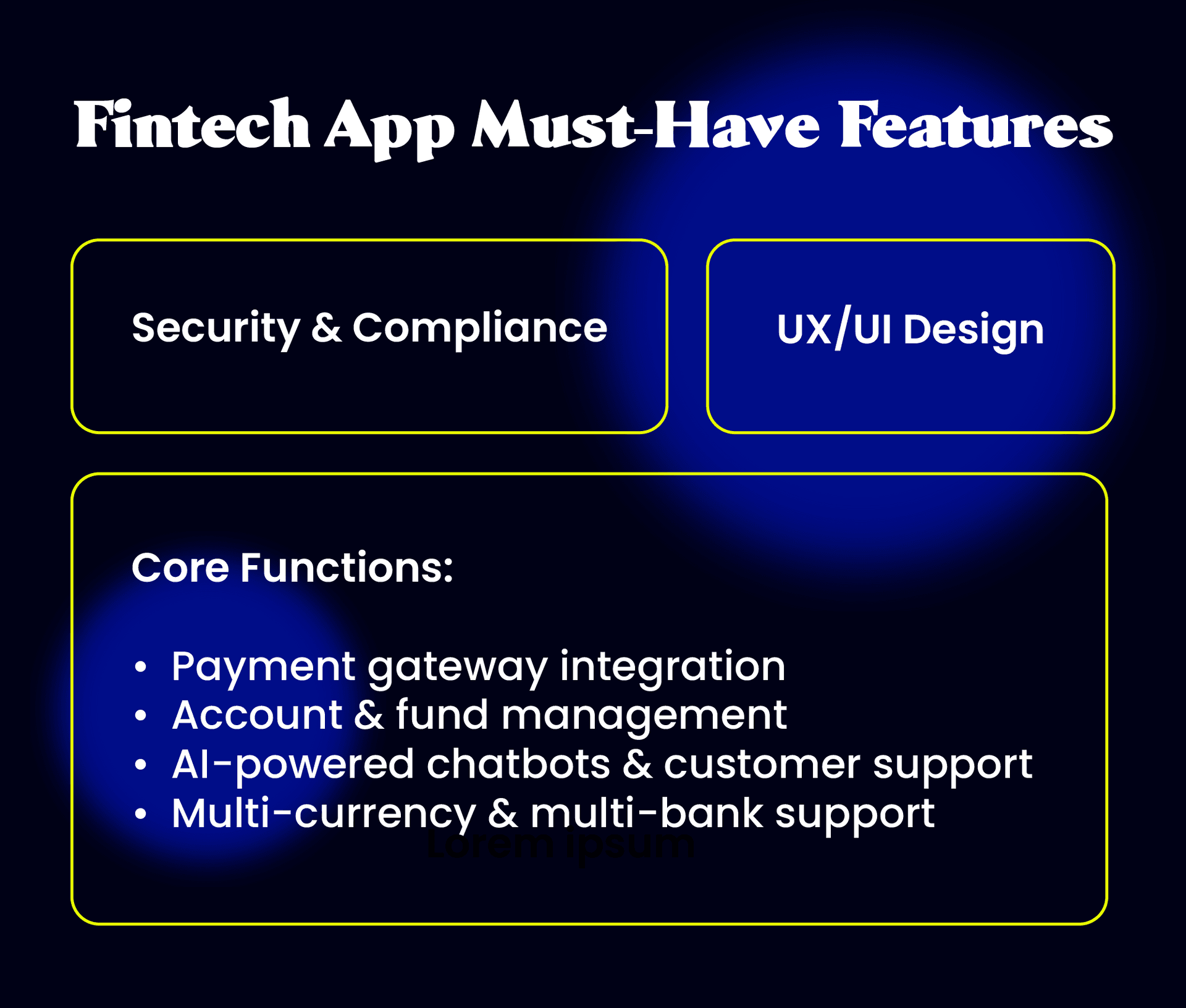
Security & Compliance
-
Strong data encryption
Fintech-relevant companies are obliged to integrate the AES-256 and TLS 1.3 data encryption protocols to ensure the security of data at rest and in transit. Applying Hardware Security Modules (HSMs) can be an additional source of protection enhancement applied to key storage and key rotation.
-
2FA & biometric authentication
2FA authentication is about a two-step process of identity authentication: the password and an additional factor such as OTP, SMS with code, or biometrics.
Biometrics represents an advanced level of authentication as it contains personalized individual characteristics, minimizing the chances for manipulations. Physical biometric protection includes fingerprints, facial recognition, and voice detection. Behavioral biometrics incorporate gait and handwritten signatures.
-
PCI DSS & GDPR compliance
PCI DSS is a set of requirements that obliges vendors & business organizations to ensure the safety of the cardholders’ data within the complete payment cycle, especially, touching the major card brands: Visa, Mastercard, American Express, JBS, and Discover.
Fintech apps must be compliant with GDPR, which is a strict regulation on data processing. GDPR requires business organizations to provide safe, fair, lawful data operability data subject (client), with the possibility to correct info per request and request-based accessibility.
-
Tokenization & 3D Security
Tokenization is about transforming card-relevant info into a string of no-sense symbols, which do not expose sensitive monetary details.
3D security is a security measure that requires identity verification by the card issuer during the payment procedure. The customer visits the bank’s page and verifies activity via the password linked to the card.
User Experience & UI Design
-
Simple onboarding & intuitive navigation
The simple onboarding in a fintech application includes minimal data entry (the most necessary info), options for social sign-in (from Google accounts), visual tutorials (simple videos on the application’s core features), progress visualization (indications of the stage of the onboarding completion),
When it comes to intuitive navigation, the must-have elements of the fintech application include gesture control (swipe logic for routine tasks), hierarchical structure (the app’s design is divided into logical sections), and optimized workflow (minimized number of steps to perform the basic actions).
-
Multi-device responsiveness
Multi-device responsiveness covers design considerations and in-app cross-platform functionalities. When it comes to first, the elements such as flexible layout (the platform’s adaptability to different screens), and consistency in branding (preservation of the unique design characteristics updating for the device-specific features).
Cross-platform responsiveness is about automatic adaptability to the versatility of screen devices (iOS and Android), feature adjustment according to the devices’ capabilities, and optimized transitions (the capability of starting the action on one device and its continuation on the other).
Core Functionalities
-
Payment gateway integration (Zelle, PayPal, bank APIs)
Integrating a payment gateway is a must function in the fintech app to process transactions over the single payment interface (to bring convenience in handling versatile payment methods via a single platform), transaction monitoring (payment-relevant real-time tracking), abidance by the legal considerations (GDPR, PCI DSS).
Zelle is integrated to handle direct bank-to-bank transfers within the US financial ecosystem.
PayPal is integrated as one example of a gateway to optimize peer-to-peer transactions, emphasizing global payment processing.
Bank APIs are about seamless integration with banking systems to ensure real-time transaction monitoring.
-
Account & fund management
A reliable and evolving fintech platform will present a plethora of seamless account features, including the account overview dashboard (to observe the balances on the connected accounts), category handling (custom customization regarding expenses), and custom alerts (notifications on the account activities and payment thresholds).
The fund management tools include scheduled payment logic (to set the date of the fund movements), rapid transfers (seamless money movements between the linked accounts), and budgeting tools (creating, tracking, and updating spend limits per category).
-
AI-powered chatbots & customer support
AI-driven chatbots provide assistance based on the user’s behavioral patterns and guide clients through the problem-solving steps. Additionally, AI-powered chatbots can give custom recommendations or services based on the insights from the client’s needs. The 24/7 availability and multi-language boost the app’s convenience.
-
Multi-currency & multi-bank support
The efficient fintech application has to ensure the multi-currency real-time conversion (seamless exchange between different countries), support multi-currency wallet logic (the capability of handling multiple currency wallets in one app), support of international payments (inclusion of methods that facilitate cross-border payments via auto-currency conversion).
The multi-bank support ensures safe API interconnectedness (safe connection with the various banking systems) and cross-bank transfers (supports the capability of seamless fund transfers between different banks).
Monetization Models for Fintech Apps
Crafting full-fledged fintech applications generates market demand considering their technological security, effectiveness in operations, multiple opportunities, and time-saving. Statista experts view that the Digital Payment market will grow to 4,805.00m users by 2028. The profitable fintech application types are big data, mobile banking apps, and P2P payment services. Besides the above-demand aspects, monetization is an additional pro point in financial app development worth mentioning.
The monetization model aims to answer the question: Who is going to pay?
Subscription model (Customer)
The subscription model of monetization means that the clients will pay for using the service. For instance, the client of Digit will have to pay $5 after the 30-days free trial.
Freemium (Custom Software Owner/Customer)
The freemium monetization model implies that the financial technology application owner provides the clients with the 'standard' app functions. However, those who want to get the complete range of possibilities have to pay a premium.
Gamification In-App Model (Advertiser)
This model promotes collaboration between the fintech application owner company and the high-end ad partner, like the Khan Academy. When using the app, the customer will see a gamified commercial for Khan Academy service.
Technology Stack for Fintech App Development
In order to know how to create a fintech app from a practical perspective, you need to select the appropriate tech stack, as it will guide the app’s architecture, determine its data preservation patterns, and encompass its core functionalities.
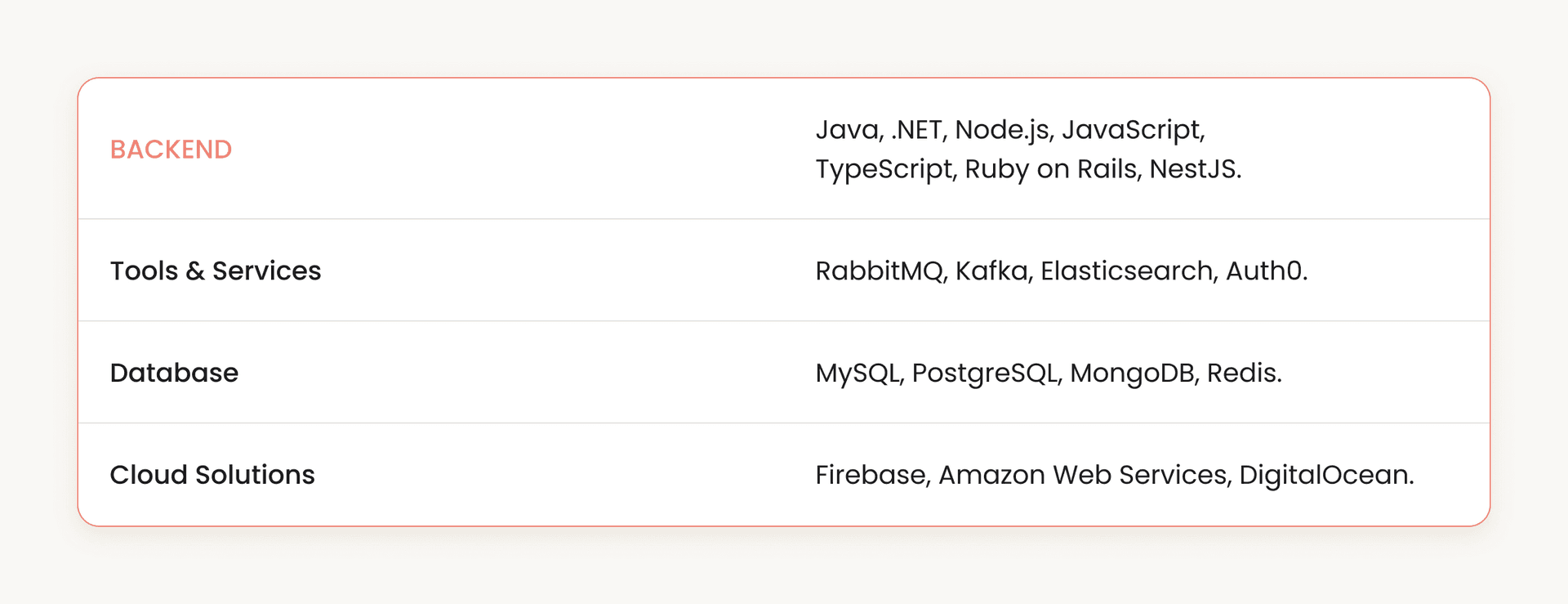
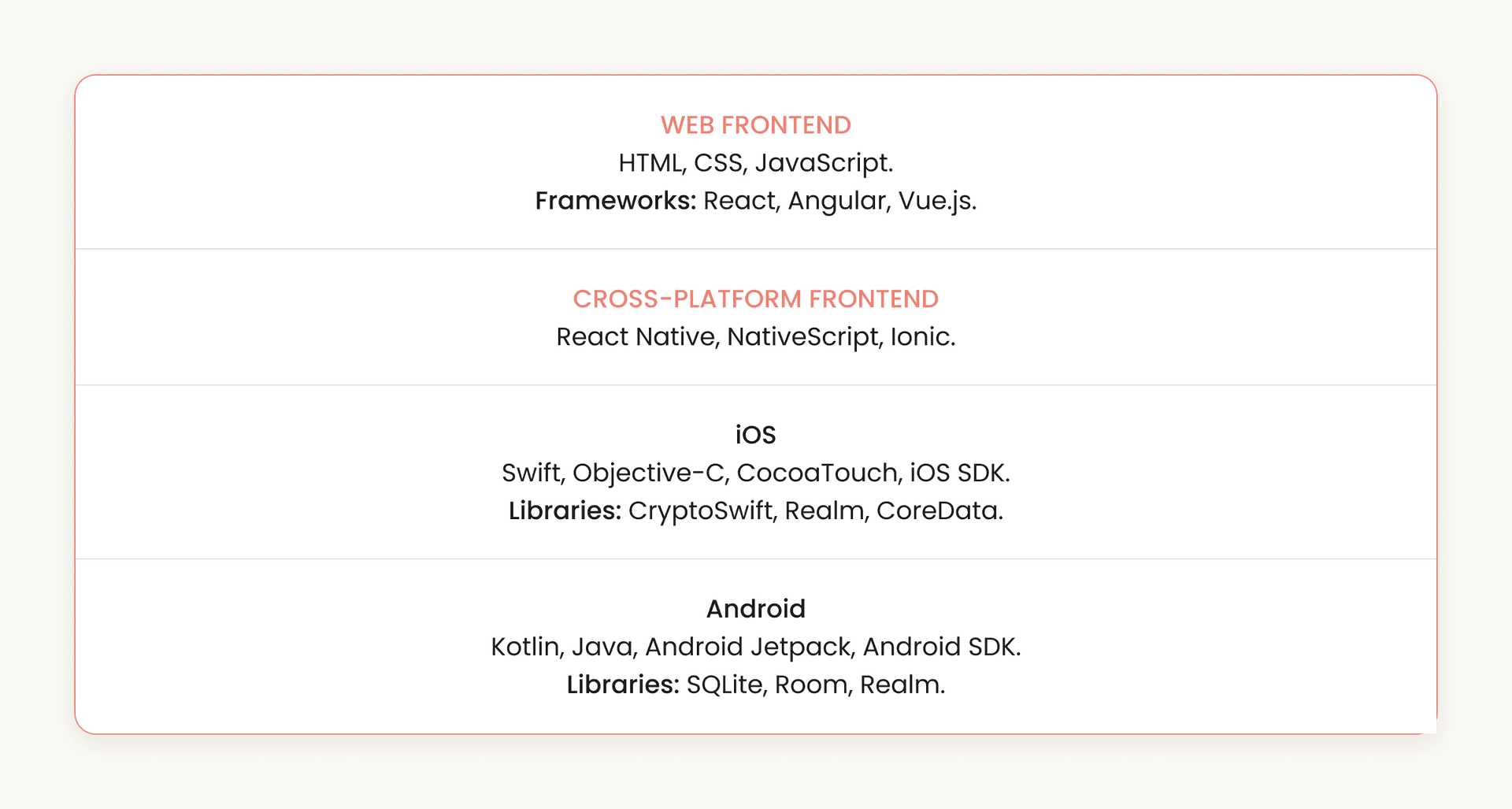
Let’s discuss some practical tech stack-relevant cases of fintech application development.
Bank of America (Mobile App)
Frontend Development:
Swift (iOS), Kotlin (Android), Python
Backend:
Java (for microservices architecture), Spring Framework,
Database Management:
Oracle (for handling banking operations)
Security:
SSL encryption
API Architecture:
RESTful APIs (internal & external service integration)
Authentication:
OAuth 2.0 (for safe user authentication)
Ally (Mobile Bank)
Frontend Development:
React Native (cross-platform mobile development)
Backend Infrastructure:
Node.js (for microservices architecture), Express framework
Database Management:
MongoDB (for flexible data storage), PostgreSQL (for handling transactional data)
Cloud Platform:
AWS-based infrastructure (for scalable cloud computing)
API Management:
GraphQL (for data querying), REST APIs (for service integration)
Monitoring:
New Relic and Datadog (to monitor application performance)
DevOps:
Jenkins and Docker containerization: CI/CD pipeline
AWS Services:
EC2 (for computing), S3 (for storage), and RDS (for database management)
Microservices Architecture:
Kubernetes (for managing containerized services)
Security Measures:
AWS Shield (for DDoS protection), AWS WAF (for web application firewall)
Step-by-Step Guide to Building a Fintech App
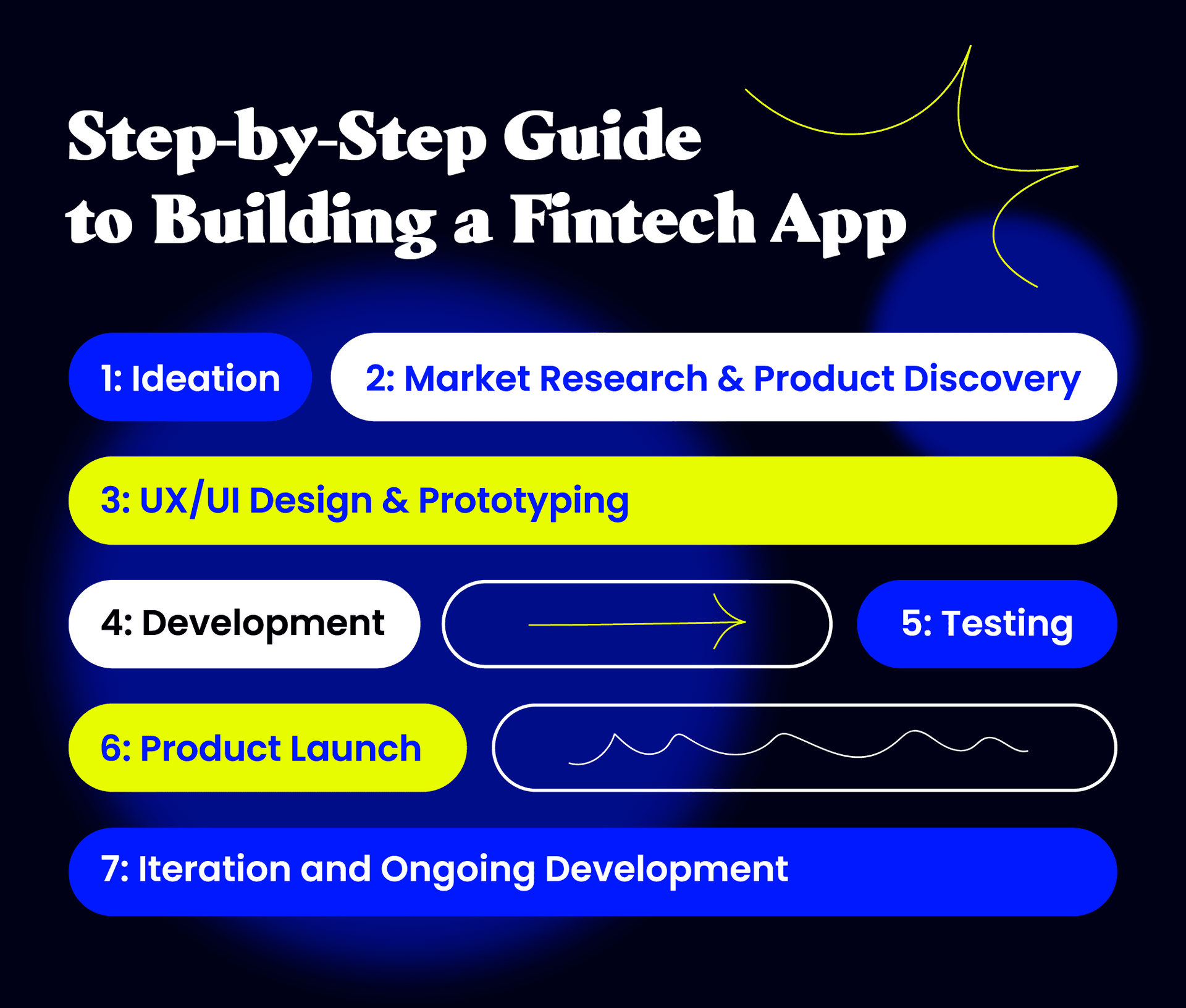
Enough attention was dedicated to the fintech app types, monetization, and must-have features. Now, let’s explore the development steps for creating a fintech app with security compliance.
Ideation
The first step of any product development is ideation. During this step, clients need to come up with their product’s concept and describe it in detail. Then, the development team and the client create a step-by-step plan to ensure the whole development process is well-organized and structured.
Market Research & Product Discovery
The discovery phase is a stage when the work on product development begins. Study the market and the existing fintech applications to find out all the pros and cons of the apps on the market so that we can make a better product.
 Get an ultimate guide on the project discovery phase and learn all the nuances of this step.
Get an ultimate guide on the project discovery phase and learn all the nuances of this step.
The product discovery will also help understand whether the fintech app is worth creating. Usually, this process consists of the following stages:
-
Study the users’ demands
-
Create a picture of your users
-
Get to know what users say and what issues they have
-
Create a visual mapping to get a complete picture
-
Gather users’ feedback
-
Try to understand whether this product solves users’ issues while remaining objective
-
Validate the theories
UX/UI Design & Prototyping
The next stage is creating UX design, which includes such steps as prototyping, creating product logic, and smooth navigation. The UI design is applied to ensure cutting-edge in-app activities, including crafting the following components: dashboard design, transaction interface, and presentation of security elements.
Development
The development represents the practical way of crafting the fintech application of the needed type. The stage includes:
-
Crafting the backend to ensure the application contains all the required features that function in a cohesive and balanced manner.
-
Engineering frontend to promote effective app responsiveness and intuitiveness.
-
Implementation of the security measures.
-
Integrating databases to proceed with data storage.
-
Tailoring native or cross-platform applications
Note: The native app is based on separate code logic, enabling it to handle extensive loads and ensure the seamless functioning of the advanced UI/UX design patterns.
The cross-platform is based on a single-code basis, enabling the parallel coverage of all the required app components on both iOS and Android. Nevertheless, it’s less intuitive than the native development as it will experience lagging in the unique animations or any other UX/UI components.
Testing
The next move is to test everything out. Functional testing is applied to check whether the functions run properly and circulate correctly with each other.
Performance testing is about checking the platform’s functionality under the concurrency.
Security testing checks whether there are tech errors in the system, and analyzes the platform’s compliance with the security standards.
Product Launch
When the project is complete, it’s time to upload it to marketplace hubs like Google Play and the App Store. Then, it's time to collect feedback about the fintech app, which is essential as it helps to find out whether the product needs improvement. Consider the following questions to navigate an effective product launch:
-
Is an app comfortable to use?
-
Did you face any issues while using an app?
-
Does this app satisfy your needs?
-
What do you want to improve?
-
Does this app meet your expectations?
Iteration and Ongoing Development
Is developing the fintech app the final stage? After the product is released, the work doesn’t end. It's quite the opposite. After getting users’ opinions on it, you have to continue improving it by handling bugs and updating new features and app versions.
How Much it Costs to Build a Fintech App (and How Long it Takes)
Building a full-fledged financial application depends on the budget. There are two central questions to answer: how much does it cost to build a fintech app? and how long does it take to build a fintech app? Among the factors that may influence the final price and time of the product are the location of your development team, the app’s functionality, and the number of changes needed. Let’s break down the overall development time and approximate range of fintech app development cost, focusing on the project’s complexity.
Simple Project
The approximate development cost of a basic fintech application will be about $80,000 - $215,000+, and the time of 5-7 months.
The reasoning behind the time and price relates to the selection of the basic features, and so the tech stack for maintaining simple app functionalities (e.g., simple authentication, basic UI/UX design interface).

Middle-Based Project
The approximate cost of developing a middle-based fintech project will range from $220,000 to $365,000+ within 7-9 months.
The complexity of in-app functionalities determines the cost range, as the middle-range project covers multiple payment gateways, robust security measures, and custom analytic dashboards.
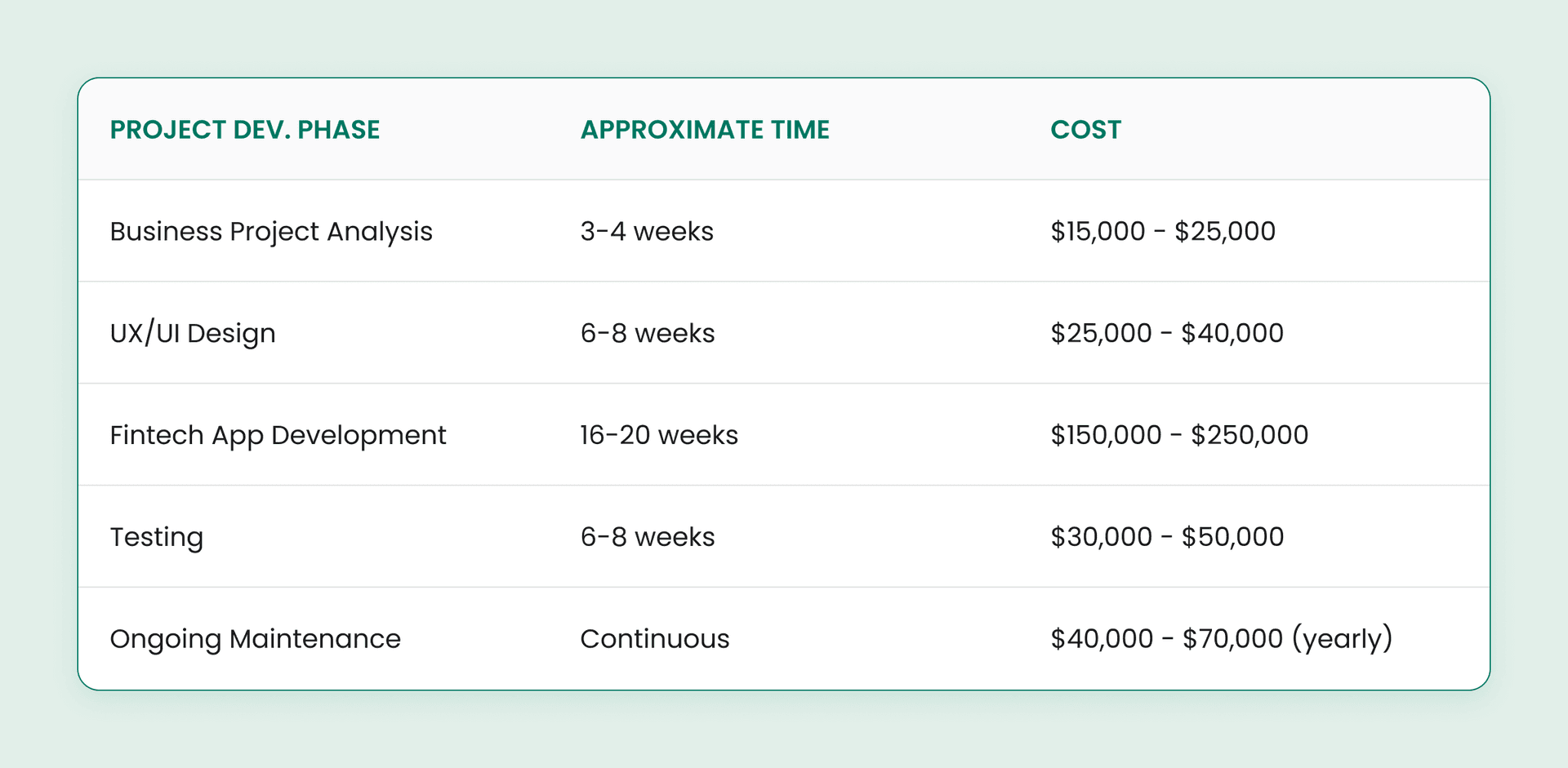
Large Project
When it comes to the costs, the approximate price range for the large fintech platform project will be around $440,000 - $730,000+ within 11-15 months of development.
The price falls under the robust features and approaches to software development, including cross-platform app support, advanced security measures, biometric authentication, real-time analytics, versatility of third-party integrations, etc.
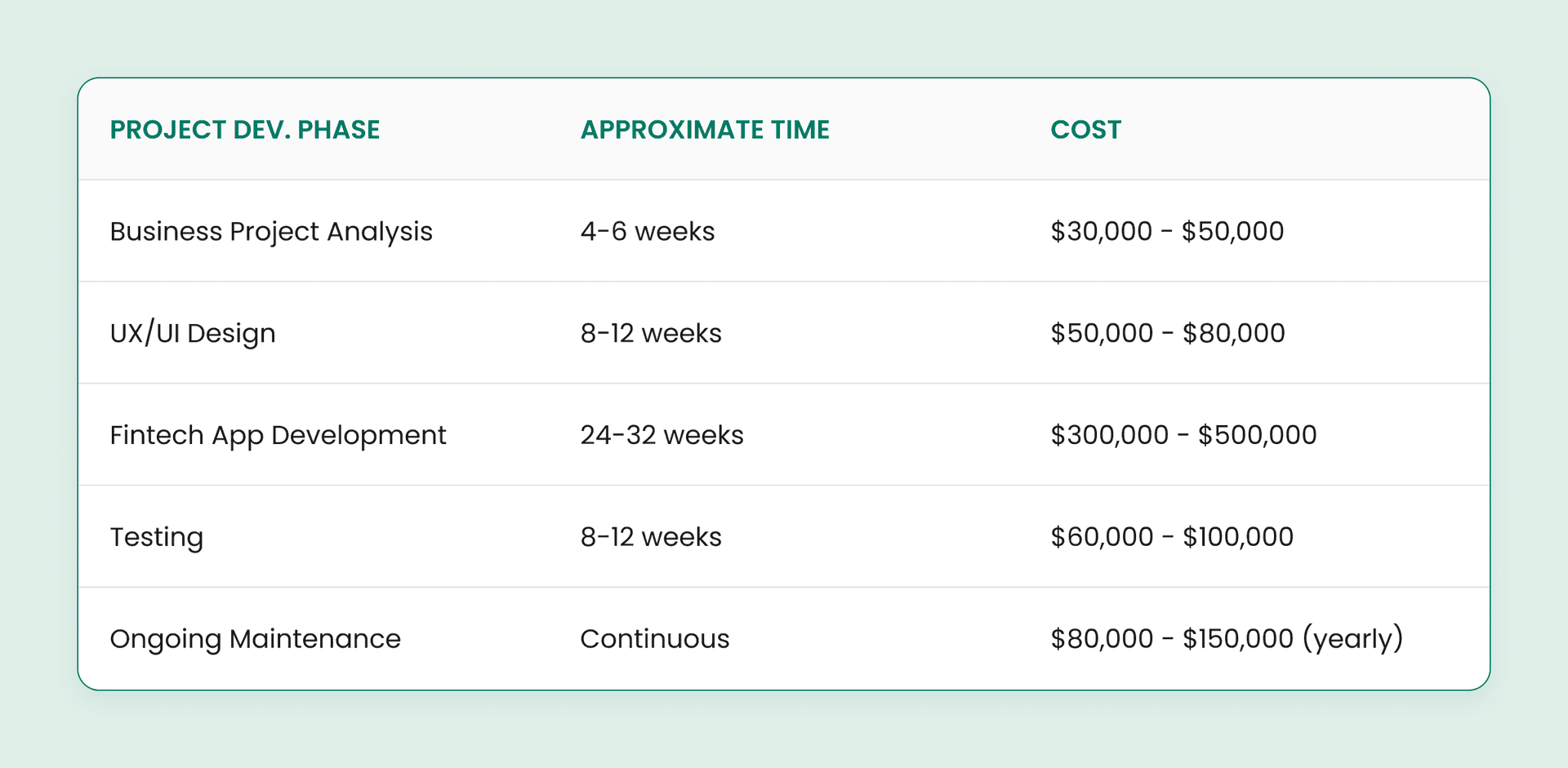
How Agilie Builds Secure & Scalable Fintech Apps
Developing a compliant fintech application is quite a challenge and demands versatile expertise. Agilie excels at tailoring client-centric customized solutions from scratch and optimization projects within the mobile banking, payment, and blockchain segments.
 Learn more about Agilie’s competence and expertise
Learn more about Agilie’s competence and expertise
Choosing a reliable development team will economize your time, resources, and ensure you with the best result. You will need a full team that consists of such specialists as a Business Analyst, Project Manager, UX/UI Designer, Front- and Back-End Developers, QA Engineer, and DevOps.
Our team of experts collaborated with Level01 on product architecture and prototypes. As a peer-to-peer decentralized finance platform, Level01, aims to provide its users with fairly trading options regarding the crypto exchange, by letting them create and manage their own digital wallets. Due to flexible SDLC, Agilie tailored a cross-platform frontend solution to cover both Android and iOS systems to optimize the application's operating system maintenance.
Another case of successful project completion is Chameleon Pay. Our major task was ensuring the applications and key security. Our dedicated developers elaborated on the following logic: the device stored the encrypted password hashes (SHA 256 algorithms) for correctness verification. Finally, Agilie implemented a biometric approach to block online wallet cases through TouchID / FaceID.
Summary
Fintech app development is a complex yet promising process based on the high demand for the relevant services. When thinking about engineering, consider what exact type of app you need, analyze the market, and select the overall scope of features as it will determine the complexity of the projects, designating the spectrum of costs and dev. time.
 Aiming to create a fintech application? Contact us to get top-notch software development experience.
Aiming to create a fintech application? Contact us to get top-notch software development experience.